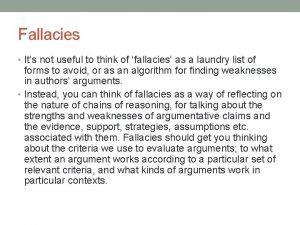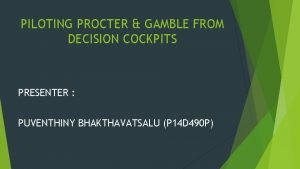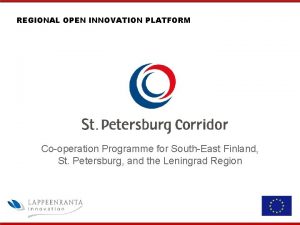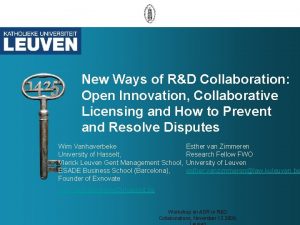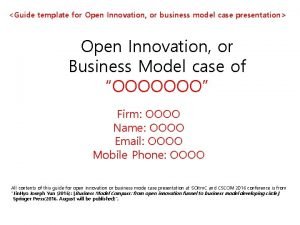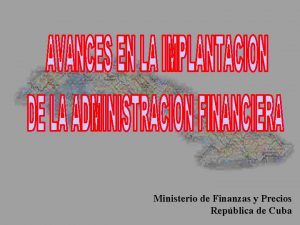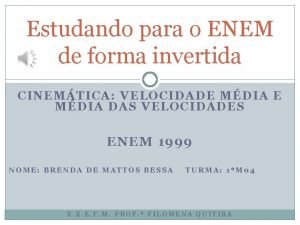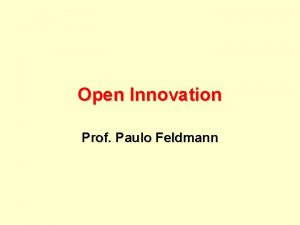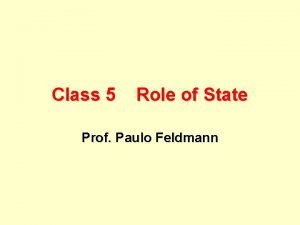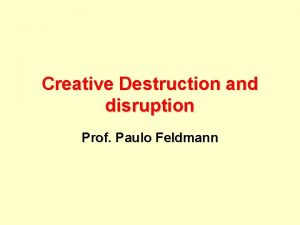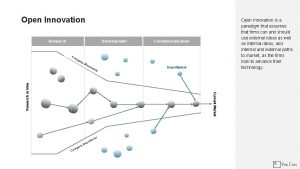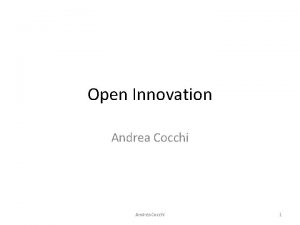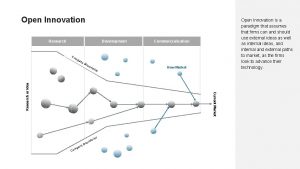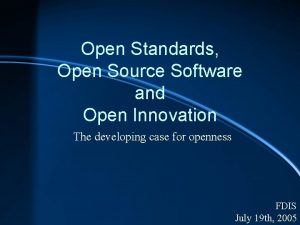Open Innovation Prof Paulo Feldmann In 1999 Procter





















- Slides: 21

Open Innovation Prof. Paulo Feldmann

In 1999 Procter decided to radically change their model of innovation. • It created the position of Director of External Innovation for the job of outsourcing, outside of its walls, in search of new innovative ideas. • The logic was: Procter counted on approximately 8600 scientists but outside the company there were 1. 5 million. Why try to invent everything internally? 2

Principles of Closed Innovation • 1. The best of our area work for us. • 2. In order to profit from R&D we must discover how to develop and supply results. • 3. Secrecy is fundamental. • 4. We need to have control of our patents in such a way that the competitors do not benefit from them. 3

Principles of Open Innovation (according to Chesbrough) • 1. Not all of the best work with us. • 2. External R&D can create value. Internal R&D is necessary to conquer part of this value. • 3. Constructing a better business model is more useful than arriving first. • 4. We have to produce income with third parties using our patents. 4

What is the ideal model? Open or Closed? Open Closed Development of products Is done by being partners with universities, research centers and other companies. Is limited to mobilizing internal resources. People – HR Valorize talented people inside and outside the company. Iinvest only in the talents of the company itself. Pioneerism There is no obsession to launch products before the competition. The important thing is to have a profitable product. There is a hurry to launch products. It is overly concerned with originality. Intellectual Property License patents for third parties and incorporate technologies of others. Control its patents and impedes third parties from using them.

The search for knowledge outside of the company as a means of obtaining competitive advantage: case studies of the use of open innovation in Brazilian industrial companies.

Some other companies outstanding as being highly innovative • Braskem – Among the top 50 in the magazine Fast Company • Cristália – award FINEP (2007) as the most innovating company in Brazil • • • Embraer – Ranking of the European Commission Marcopolo - Ranking of the European Commission Natura - Reporting of the 100 Insead/Forbes Oxiteno –Reporting of the 100 Insead/Forbes WEG - Ranking of the European Commission 7

If it is not the external environment, then what is it in the management of these same ? • 1. Well-defined procedures; 2. internal discussion channels; 3. processes of industrial meetings inducive to creation; 4. strategy for innovation; 5. R&D space on the organogram; 6. R&D Organogram; 7. well-mounted teams; 8. teams that relate well to one another; 9. financial incentives; 10. selective process to search for talent; 11. internal culture and work environment; 12. intra-entrepreneurialship; 13. interchange with universities; , suppliers and clients; 14. portfolio of projects; 15. well-conducted projects; 16. metrics. 8

Findings (I) • Emergence in the area of strategic intelligence to be responsible for the search of opportunities and partners. • There is a new aspect in the performance of employees who have become greatly valorized: the capacity to relate well with third parties. 9

Findings (II) • The 7 companies that are adept at Open Innovation while simultaneously have well-structured R&D areas and are thus recognized by their respective partners. • The search for good partners abroad was decisive for the internationalization of these same 10

Findings (III) • High environmental concern is the motto of Braskem, Oxiteno and Natura. • Of Freeman’s six strategies: (offensive, defensive, initative, dependent, traditional and opportunistic) Immitating Innovation is predominant • To be successful in the internationalization process greatly helps in the process of seeking out innovations. 11

Findings (IV) • Pro-innovation leadership that isn’t afraid of the failures was pointed out as a key factor for success in the search for innovations. For practically all of the companies a decisive aspect for success is good administration of the projects portfolio. • For most another relevant factor is that the internal culture favor innovation. 12

Findings V • For two companies developing projects together - the search for innovation becomes easier when the two have had a previous relationship. 13

Conclusions • There are Brazilian companies that are highly innovative despite the Brazilian environment which is hostile to innovation. • These companies increasingly perfect themselves in their search for knowledge which is outside of their companies. 14

Synthesis • Knowledge is fundamental for the companies but many times it is out of reach for these same. It becomes necessary to go out and find it where ever it may be. Many times it is out of Brazil. 15

Proposal • It is necessary that there would be a greater approximation between companies and universities as the first step for the dissemination of Open Innovation. • For such a public policy that motivates and stimulates this approximation is necessary.

Chesbrough • The art of open innovation is knowing when to share and when to do it. 17

Lindegard • The company that isn’t organized to do research at home shouldn’t even think about working with outside partners. 18

Conclusion The focus in the search for innovations continues but now there should be a focus in the search for good partners to innovate. 19

Conclusion • There is one more strategic resource that should be sought outside of the company : knowledge • It is that will bring competitive advantage and in this way that it will be positioned in the market 20

Conclusion • There is a new activity that should be developed inside the companies: Strategic intelligence to search for the new opporunities but also partnerships with which they will be developed. 21
 Open innovation open science open to the world
Open innovation open science open to the world Chuta sano
Chuta sano Klaus feldmann familie
Klaus feldmann familie Post hoc ergo procter hoc
Post hoc ergo procter hoc Piloting procter & gamble from decision cockpits
Piloting procter & gamble from decision cockpits Rob procter
Rob procter Important john proctor quotes
Important john proctor quotes Character list for the crucible
Character list for the crucible Piloting procter & gamble from decision cockpits
Piloting procter & gamble from decision cockpits Logic in writing
Logic in writing Mysite.socccd
Mysite.socccd Disruptive and radical innovation
Disruptive and radical innovation Tsmc open innovation platform
Tsmc open innovation platform Open innovation platform
Open innovation platform Exnovate
Exnovate Open innovation canvas
Open innovation canvas Peru junin 20/02/1999
Peru junin 20/02/1999 Berspannungsschutz
Berspannungsschutz Decreto ley 192 de 1999
Decreto ley 192 de 1999 What is the function of irda
What is the function of irda Uu no. 5 tahun 1999 berisi tentang
Uu no. 5 tahun 1999 berisi tentang Enem 1999 um sistema de radar
Enem 1999 um sistema de radar



